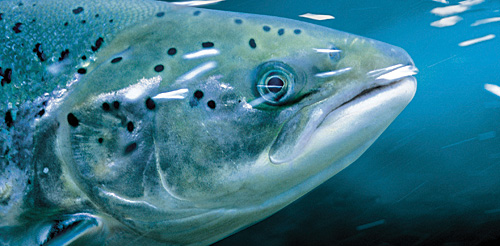It Pays to Keep Salmon Fit
OutdoorHub 09.05.12

Only 80-85 per cent of salmon smolts transferred to sea cages in Norway survive to reach slaughter size. The loss of the remainder costs producers billions of kroner each year. Escapes, disease, and handling-related injuries are the top causes, and scientists attribute a large proportion to poor smolt quality.
Swimming exercise cuts losses
“There are many reasons for poor smolt quality, but most are related to intensive production methods,” says Senior Scientist Harald Takle of the Norwegian Institute of Food, Fisheries and Aquaculture Research (Nofima AS).
Dr Takle headed a team of Norwegian and international researchers who tested various exercise regimes for three years on salmon fry, from 30-gram parr to 100-gram smolts. Most of the trials were conducted at Nofima’s Sunndalsøra Research Station, with complete control of current speed and oxygen saturation and monitoring of feed intake. The findings indicate that proper exercise can improve smolt health enough to significantly reduce losses at sea.
“We have devised what we believe approaches the optimal exercise regime for smolts during their last 12 weeks before being transferred to sea cages,” explains Dr Takle. “With this exercise the smolts develop more numerous, larger heart muscle cells and a stronger immune system. For example, the survival rate among properly exercised fish when challenged with the IPN (infectious pancreatic necrosis) virus is up to 15 per cent higher than among inactive salmon.”
Healthiest workout for salmon
“In the final 12 weeks before transferring to sea cages, smolts should be swimming 0.8 to 1.2 body lengths per second,” recommends Nofima’s Harald Takle. The exercise regime also increases bone formation and vertebral mineralisation in smolt, making them less likely to develop deformities.
Developing the innate swimming capacity of salmon also benefits their overall health. Good swimmers are more disease-resistant and withstand intensive interval exercise better than poor swimmers, which exhibit stress reactions to the exercise. In the round hatchery tanks, the intensity of the smolts’ workout sessions can be regulated by the speed and distribution of the water current.
“Our trials indicate that swimming at least 0.8 body lengths per second strengthens the salmon heart. The optimal exercise intensity for smolts in their final 12 weeks before transfer to the sea cage looks to be roughly 0.8 to 1.2 body lengths per second. Speeds faster than this can have a negative effect,” adds Dr Takle,” as can major changes in current speed.”
Industry players very interested
According to Dr Takle, many hatcheries could implement exercise regimes using a few simple measures. For others, achieving the necessary control of water current in their tanks could prove difficult. He says industry players are showing a great deal of interest in his team’s findings and have placed new orders this spring for exercise regimes, which Dr Takle intends to fill.

Project facts
- Preventive health measure by optimizing swimming exercise to counteract lifestyle diseases of Atlantic salmon
- Project period: 2009-2012
- Project manager: Harald Takle, Nofima AS
- Partners: Norwegian Institute for Water Research (NIVA), NTNU Faculty of Medicine, University of Western Brittany, University of British Columbia, AVS Chile
- Funding: The Research Council of Norway’s HAVBRUK programme and the Norwegian Seafood Research Fund (FHF)

